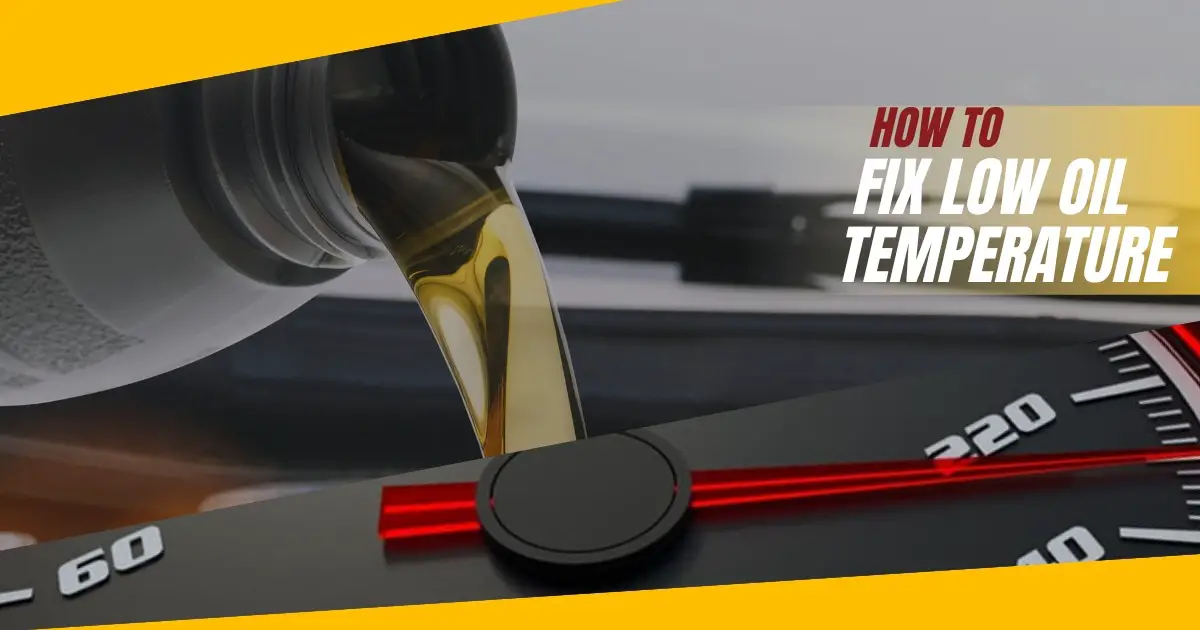How to Fix Low Oil Temperature- Common Causes and Remedies
Maintaining optimal oil temperature is important for ensuring smooth operation and longevity of the car engine. However, it is not uncommon for the oil temperature to fall below the recommended range, especially during prolonged idling periods. Additionally, highway and low-spirited driving typically keep oil temperatures relatively lower.
This is because the engine isn’t working as hard, so it doesn’t generate as much heat. Now, low oil temperature isn’t usually a problem, as long as it’s not too extreme. However, if the difference between the oil and coolant temperature is too big or if the oil temperature keeps changing a lot, then it might be a sign of a problem that needs to be looked into.
Why is My Oil Temperature Low?
When the engine oil temperature falls below the recommended range, it can spell trouble for various components within the system. Ideally, cold oil affects engine performance and efficiency, as well as the lubrication and protection of critical parts. Symptoms of low oil temperature may include decreased engine performance, increased fuel consumption, and increased engine wear due to inadequate lubrication.
What Causes Low Engine Oil Temperatures?
A Highly Efficient Oil Cooling System
A highly efficient oil cooling system can inadvertently lower engine oil temperatures, especially if it’s overdesigned or operates too effectively for the given driving conditions. If your cooling system is overworking, it can lead to lower-than-optimal oil temperatures, as it effectively removes heat from the oil faster than necessary.
High Oil Capacity
Engines with larger oil capacities may take longer to heat the oil to its optimal temperature. With more oil to heat up, the engine may require additional time to reach its ideal operating temperature. Consequently, you may experience low oil temperatures, especially if the engine is not operating for long durations.
Cold Weather
Cold weather can pose various challenges for your vehicle, including the engine oil. Generally, the ambient temperatures often make the engine take longer to reach its optimal operating temperature, leading to low oil temperatures. Cold weather can also cause the oil to cool down more quickly, especially during startup.
Low Engine Load
If you’re not utilizing the engine to its full capacity, it does not generate enough heat, which can lead to lower oil temperatures. Ideally, when the engine load is low, the combustion process is less intense, resulting in less heat being generated by the engine.
As a result, you may experience low oil temperatures as the engine tries to reach its ideal operating range. Typical applications that require low engine load include highway driving and other light applications that do not operate under significant load for extended periods.
A Faulty Thermostat
The primary role of the thermostat is to regulate the flow of coolant through the engine to maintain optimal operating temperatures. If the thermostat is stuck open or not working as expected, it might allow too much coolant to flow, leading to lower overall engine temperatures. This can result in the engine running cooler than intended, affecting the oil temperature as well.
Improper Oil Viscosity
If you are using oil with a viscosity grade that is too high for the operating conditions, it can impede its ability to flow freely. This can result in slower oil circulation and longer warm-up times for the engine, which, in turn, delays the oil reaching its optimal operating temperature. However, once the engine warms up, the oil should reach its appropriate operating temperature within no time.
Oil Cooler
If your car is equipped with an oil cooler, it can experience lower oil temperatures, particularly during highway driving. The cooler helps dissipate heat from the oil, which can be beneficial in preventing overheating. However, if you are driving under ambient conditions, it can make the engine oil temperature remain consistently low.
Faulty Oil Temperature Sensor
The oil temperature sensor provides data to the ECU about oil temperature. If the sensor is faulty or sends incorrect signals, it may result in inaccurate oil temperature readings and improper engine management. As a result, the control unit may fail to adjust engine parameters appropriately, leading to low oil temperatures.

How to Fix Low Oil Temperature
Now that you know why your engine oil temperature is low, what can you do about it? Low engine oil temperature is often not a cause for alarm, especially if it is not causing any immediate issues with your vehicle. However, if you are concerned about the impact of low engine oil temperature on your engine’s performance, here are some steps you can take to rectify the issue;
I. Allow the Vehicle to Warm-up
The most effective method to raise a car’s oil temperature is to drive it for a few minutes. If you’re starting your car in colder conditions or after extended periods of inactivity, always allow the engine to warm up gradually by driving gently. This will allow the oil to warm along with the engine components while ensuring proper engine performance.
II. Considering Synthetic Oil
Synthetic oils are formulated to maintain their viscosity better in extreme temperatures, including cold weather. When the engine is cold, conventional oils often become thicker and flow less efficiently, leading to longer warm-up times and lower oil temperatures. However, synthetic oils remain more stable and flow more readily, allowing them to reach optimal operating temperatures more quickly.
III. Use an Engine Block Heater
An engine block heater is typically installed in the engine block and plugged into an electrical outlet. Its primary role is to heat the engine’s coolant, which, in turn, warms up the engine block and internal components. In other words, the heater helps preheat the engine, meaning the surrounding oil will also warm up more quickly.
IV. Drive at Higher RPMs
Driving at higher engine speeds can generate more heat, which helps raise engine temperature. As a result, the oil temperature gradually increases as the engine revs higher. In addition, high RMPs help to stabilize oil temperatures and prevent them from dropping too low. However, you may want to be cautious not to rev the engine excessively to avoid component damage.
V. Check for Engine Problems
If you’ve done all the above but the problem persists, consider troubleshooting the engine. Low oil temperature can sometimes be a symptom of an issue with the engine itself or associated components. As such, evaluate the engine thoroughly for faulty components that could hinder proper engine oil warming and address them accordingly.
Conclusion
Identifying the symptoms of low engine oil temperatures helps car owners understand what’s normal and what’s not when it comes to keeping their engines running smoothly. Luckily, low oil temperature is usually nothing to worry about unless something unusual is happening, like the temperature changing a lot. That said, it is always a good idea to be on the lookout for abnormal oil temperatures that can lead to complications down the road.






